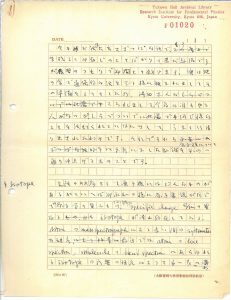Archive of historical materials

Lecture draft : Nuclei and Positrons
OU1935-B2 (29 pages) Date: None
This is a draft of lecture manuscript written on horizontally lined manuscript sheets printed with “Osaka Imperial University, School of Science, Department of Physics.” In this manuscript, Yukawa thoroughly explained the issues pertaining to the atomic nuclei at that time and described the discovery of positrons. The target audience was the students and professors in the Department of Physics. He started the lecture by saying, “Today’s topic is very general and broad. I hope my lecture will refresh your memories.” However, he talked about very advanced, cutting-edge subjects in good order. Yukawa used to write manuscripts for lectures in a conversational tone.
Yukawa began his lecture by explaining the data of the mass defects of various atomic nuclei and isotopes obtained in experiments. He presented the data of nuclear reaction and then elucidated the nuclear force. During the explanation of neutrons, Yukawa referred to many experiments conducted by Chadwick. Then, he talked about positrons. His presentation of the description of positrons was overwhelming. First, Yukawa described how C. Anderson discovered the positrons while he was conducting research on cosmic rays, and gave details of the experimental observations. In this lecture, Yukawa explained how it was experimentally confirmed that the observed particle had the same mass as an electron and had the same electric charge as a proton. Interestingly, Yukawa added the following comment in the margin of a page in the lecture draft: “Dr. Anderson called it a positive electron or positron, and he named a conventional electron a negative electron or negatron.” Later in his lecture, he explained that a cosmic ray shower was eventually observed, that positrons were present in the shower and that various nuclear collision reactions resulted in the emission of positrons.
Near the end of the lecture, Yukawa began expounding Dirac’s theory of positrons. Historically, Dirac’s paper preceded the discovery of Anderson, but there were few physicists at that time who understood Dirac’s paper and believed the existence of positrons. Yukawa impressively explained that the holes in the Dirac sea behaved much like positrons and that Dirac named those particles anti-electrons. Interestingly, Yukawa added at the end of the manuscript a table of isotopes, chart of mass defects and list of nuclear reactions.
The discovery of the neutrons and positrons in 1932 brought a breakthrough to the world of physics. In Japan, only Osaka Imperial University and RIKEN had staff members who were able to explain the breathtaking, most advanced theory of physics accurately and logically from both experimental and theoretical aspects for easy understanding. (Written by Yutaka Hosotani)


